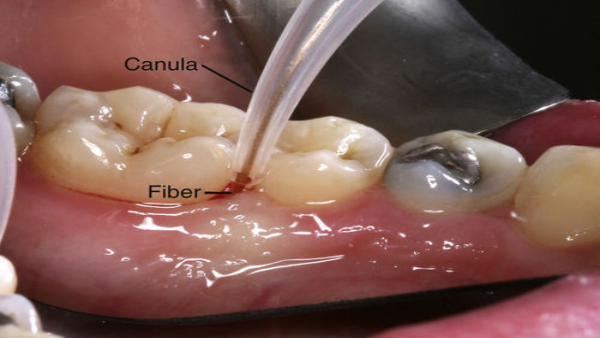Diode Laser Treatment for Periodontal Sterilization
Abstract
Laser is a major invention of mankind since the 20th century, known as "the fastest knife", "the most accurate ruler", and "the brightest light". Its application in medical treatment is divided into: laser surgery treatment, non-surgical treatment of low-energy laser biostimulation and photodynamic therapy of laser.
1. The principle of diode laser application in periodontal sterilization treatment (Non-surgical treatment)
Diode lasers have been used in periodontal pocket decontamination for 15 years. The wavelength emitted by the high-performance semiconductor laser is in the near-infrared band of 810nm-980nm. Thanks to the strong absorption effect of hemoglobin in this band, semiconductor laser is very suitable for soft tissue cutting in oral surgery, removal of benign tumors in the oral cavity, implant exposure and various gingival mucosal operations. In addition, semiconductor lasers are also very suitable for killing bacteria on the surface of teeth or implants.
2. The operation process of diode laser treatment for periodontal sterilization
Treatment of periodontal pockets is generally time-consuming and complex. The steps of using semiconductor laser for periodontal treatment are as follows:
1. Comprehensive oral examination and filming.
2. Full mouth periodontal probe detection.
3. Subgingival scaling and root planing were performed after local anesthesia.
4. Oral laser irradiation in the periodontal pocket:
Laser irradiation sterilization is the core part of the whole treatment process. Set the laser power to 1 Watts in continuous mode, or 2 Watts in pulsed mode. The fiber optic tip needs to be initialized and brought into contact with the tooth surface. Each treatment is about 20 seconds per tooth or implant. Through these settings, the bacterial flora that causes periodontitis can be effectively destroyed, and at the same time, there is no thermal damage to the pulp or implant and periodontal tissue.
5. Wipe to remove tissue debris attached to the fiber tip.
6. Repeat steps 4 and 5 until no tissue debris is attached to the fiber tip.
7. Finish the treatment and return to the clinic one week later.
3. Conclusion
The semiconductor laser with a wavelength of 810nm-980nm has penetrability and pigment absorption, and has a good bactericidal effect on some pathogenic bacteria of periodontal disease, and can also remove granulation tissue in periodontal pockets. Because it is a penetrating laser with low energy, anesthesia is often not required during treatment. Periodontal pocket decontamination using diode laser can be performed simultaneously with subgingival scaling and root planing. Studies have confirmed that the application of semiconductor lasers can reduce the bleeding index of the gums and reduce certain pathogenic bacteria in the periodontal pockets. The patients feel more comfortable and the wounds heal more quickly.
